by Elisa Brunelli
In recent years, attention has primarily focused on surface coating, in order to obtain high performance cellulosic packaging, with completely new properties that enable competing with synthetic polymers. These ultrathin organic or inorganic coatings cover the outermost layer of cellulose and are able to improve their mechanical and chemical characteristics.
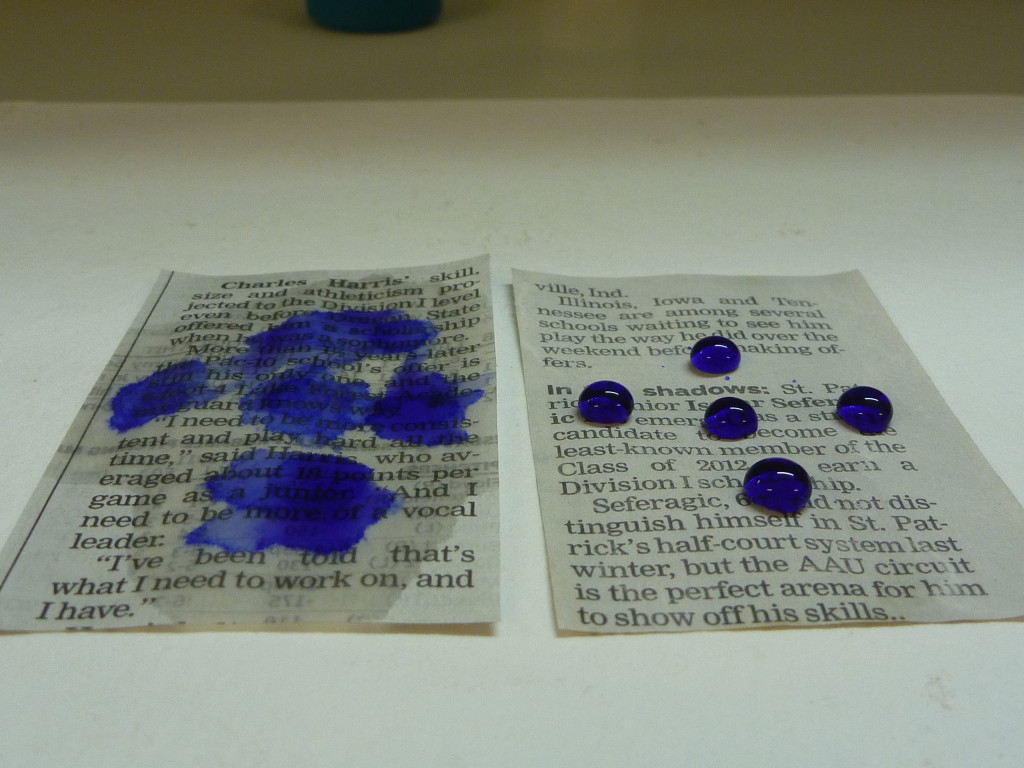
During the conference «Cellulosic Materials and Packaging: from research to new business applications», organized by Comieco in collaboration with Politecnico di Milano and Università degli Studi di Parma, Cipack research group from Parma presented the draft of a waterproof and grease-resistant paper, thanks to next-generation coatings.
Hydrophobic cardboard
Packaging made from cellulosic material offers numerous advantages both in terms of mechanical performance and environmental sustainability. However, when compared to synthetic polymers it is sensitive to external influences, in particular water, whose penetration drastically alters its resistance. In the laboratories of the University of Parma, the research team coordinated by Andrea Lorenzi has developed inorganic coatings to increase cardboard and paperboard water resistance. «Wettability and water resistance of a surface does not depend only on the material it is made of, but also on its roughness.
Only a few solid surfaces are truly flat, most have bumps that affect the behavior of water that comes into contact with it. Depending on the micro geometry of surfaces, water can penetrate their roughness or remain suspended on it. These situations are referred to as “penetration” and “suspension” conditions, and precisely these two theoretical models form the guidelines for developing hydrophobic coatings, “says Lorenzi. An example of how the structure of a surface affects interactions with water is represented by the Lotus plant. On the leaves of this plant species water drops slip away without joining and penetrating the surface: this effect is due to superficial micro and nanostructures that combined with the epicuticular wax that covers them, give high water resistance to the surface.
Lotus Effect
At a macroscopic level Lotus leaves appear completely smooth, but observing them in detail, in fact, they have a microscopic roughness on different orders of magnitude. The images on electronic microscopes have shown that the structure of the leaf consists of a surface roughness combination on two scales: one around 10 microns (coarse texture) and another around 100 nm (fine structure). Therefore we talk about micro and nanometric hierarchical structures. Nature has been exploiting nanostructure of living matter for a very long time in order to get absolutely new properties that until recently were considered unreachable.
Take advantage of the Lotus leaf effect
Researchers at the University of Parma have tried to reproduce the Lotus leaf effect in their laboratory by developing silicon inorganic nanoparticle-based coatings linked to hydrophobic tails able to prevent water penetration.
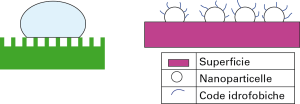
After developing the coating formulation and verifying that it didn’t significantly modify the aesthetics of paper and cardboard, the researchers carried out a set of tests on treated materials in order to evaluate the coating’s functionality. First of all they compared the absorption capacity by immersion of untreated samples with coated samples. Fragments of cardboard of the same size and weight (275 g/m2) were placed in water for equal periods of time. Evidence has shown that untreated cardboard absorbs up to 50% by weight while coated cardboard absorbs from 10% to 20%, depending on the coating, whether it is water- or alcohol-based: a result that demonstrates how the coating is able to efficiently protect cellulose from the action of water.
Improving resistance
Next, the researchers tested the mechanical properties of cardboard: after immersion in water the samples were subject to ring crush test. Also in this case the nanoparticle-based coating seems to have a very positive influence on the resistance of cellulosic material. In particular, compression resistance after immersion, compared to ‘ not wet ‘ has increased by 80% for treated samples.
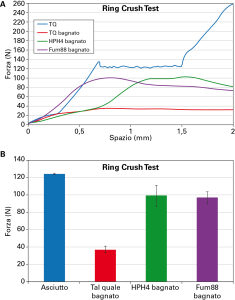
«This coating is efficient from the point of view of mechanical performance as it considerably improves the quality of cellulosic material. This type of treatment has several advantages: it does not contain plastics, so the material does not lose eco-friendliness and recyclability characteristics. Concerning its processing coating can be applied with different techniques; therefore it fits different production chains. It also doesn’t significantly affect on the overall weight of the product. The coating does not alter the material from an aesthetic point of view, it is virtually transparent, even during storage it can act as a protective barrier» concludes Lorenzi.
Unstained with biopolymers
Compared to synthetic polymers cellulose absorbs well the fat contained in various foods; penetrating inside the fibers they affect their structure by changing their mechanical properties. At the University of Parma Cipack group researchers have tested different types of coating in order to obtain increasingly lipid- resistant paper “Oil-resistance is a very important feature for cellulosic products designed for contact with food, as it guarantees the aesthetic and mechanical properties of cellulosic packaging. In our laboratories we evaluated the performance of different biopolymer- based coatings on paper and cardboard and we selected the most functional”, says Ilaria Alfieri, one of the researchers who participated in the pilot project. «Biopolymers are among the most interesting candidates for this type of treatment; they are as biodegradable as cellulose and do not affect the recycling process” continues Alfieri.
Until recently the only way to get an oleophobic paper was to add it to synthetic polymers; the latter, besides not being biodegradable, are also difficult to separate from the cellulosic substrate thus making it impossible for material recycling or recovery through composting. The development of biopolymers with good mechanical performances and with a good resistance to external agents allowed developing cutting-edge food contact cellulosic products.
Tests
Cipack laboratories have tested various kinds of biopolymers and researchers have tested polysaccharide-, protein-, and fatty acid-based coatings. Natural polymers were mixed with inorganic particles of simple silica or hydrophobic silica, modified to increase their barrier effect. In order to test the effectiveness of this coating, paper samples coated with this kind of product were subjected to turpentine standard test. The test consists in measuring, through an untreated reference sample, colored turpentine penetration after filtering it on a cone of sand that allows its even distribution.

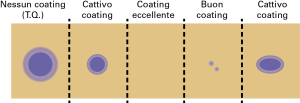
The researchers carried out the test on different substrates achieving encouraging results. Especially on ivory-colored cardboard, the best results in terms of barrier were obtained with polysaccharides mixed with simple silica.
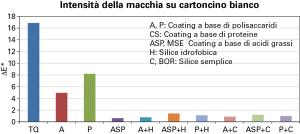
Subsequently a series of experiments have been carried out to see what happened on the cardboard in contact with fat-rich food samples (e.g. dressed pasta) put in the microwave. By measuring the size of the spots on the back of the cardboard the most oleophobic coating was the fatty co-acid- and hydrophobic silica – based coating (see picture here under). Mixing biopolymers with hydrophobic silica the researchers have been able to get an oil- and water-resistant coating at the same time.
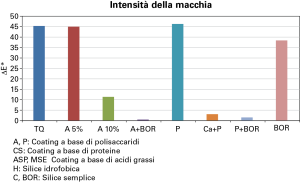
«Our coatings made from natural substances showed good fat barrier properties on different cellulosic substrates – says Ilaria Alfieri – the experiments carried out at our laboratories have confirmed that the use of silica further improves oil-repellence and modifies surface hydrophilicity. Therefore, experiments are continuing; given their good results, the next step will be to verify the effect of coatings against oils in steam phase» concludes the researcher.
Bibliography
Effetto loto sui materiali cartotecnici, 2013, Lorenzi, A.
Coating barriera sui materiali cellulosici, Ilaria alfieri 2013.
